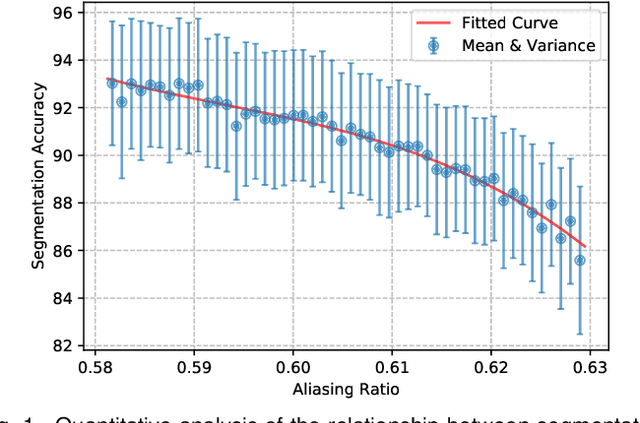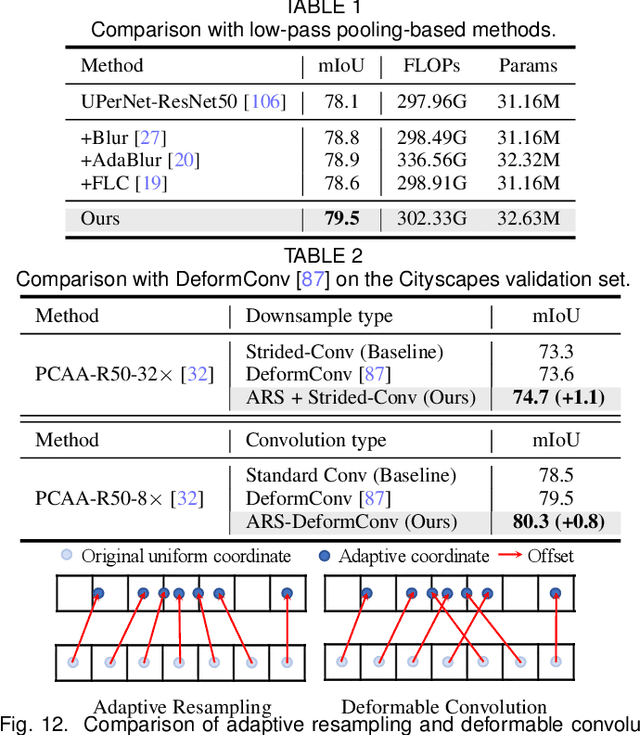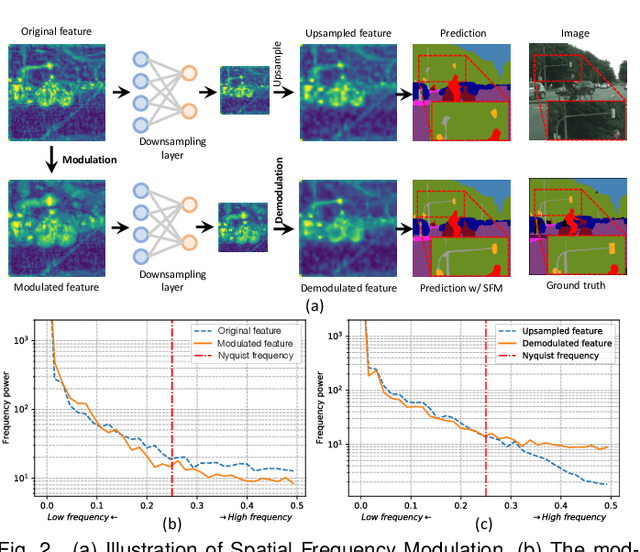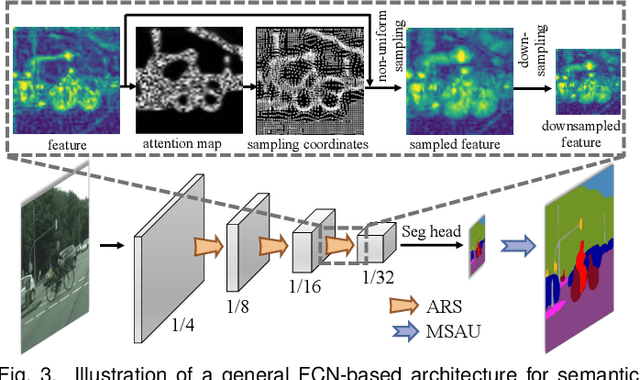Panoptic Segmentation
Panoptic segmentation is a computer vision task that combines semantic segmentation and instance segmentation to provide a comprehensive understanding of the scene. The goal of panoptic segmentation is to segment the image into semantically meaningful parts or regions, while also detecting and distinguishing individual instances of objects within those regions. In a given image, every pixel is assigned a semantic label, and pixels belonging to things classes (countable objects with instances, like cars and people) are assigned unique instance IDs.
Papers and Code
SPORTS: Simultaneous Panoptic Odometry, Rendering, Tracking and Segmentation for Urban Scenes Understanding
Oct 14, 2025The scene perception, understanding, and simulation are fundamental techniques for embodied-AI agents, while existing solutions are still prone to segmentation deficiency, dynamic objects' interference, sensor data sparsity, and view-limitation problems. This paper proposes a novel framework, named SPORTS, for holistic scene understanding via tightly integrating Video Panoptic Segmentation (VPS), Visual Odometry (VO), and Scene Rendering (SR) tasks into an iterative and unified perspective. Firstly, VPS designs an adaptive attention-based geometric fusion mechanism to align cross-frame features via enrolling the pose, depth, and optical flow modality, which automatically adjust feature maps for different decoding stages. And a post-matching strategy is integrated to improve identities tracking. In VO, panoptic segmentation results from VPS are combined with the optical flow map to improve the confidence estimation of dynamic objects, which enhances the accuracy of the camera pose estimation and completeness of the depth map generation via the learning-based paradigm. Furthermore, the point-based rendering of SR is beneficial from VO, transforming sparse point clouds into neural fields to synthesize high-fidelity RGB views and twin panoptic views. Extensive experiments on three public datasets demonstrate that our attention-based feature fusion outperforms most existing state-of-the-art methods on the odometry, tracking, segmentation, and novel view synthesis tasks.
GS: Generative Segmentation via Label Diffusion
Aug 27, 2025Language-driven image segmentation is a fundamental task in vision-language understanding, requiring models to segment regions of an image corresponding to natural language expressions. Traditional methods approach this as a discriminative problem, assigning each pixel to foreground or background based on semantic alignment. Recently, diffusion models have been introduced to this domain, but existing approaches remain image-centric: they either (i) use image diffusion models as visual feature extractors, (ii) synthesize segmentation data via image generation to train discriminative models, or (iii) perform diffusion inversion to extract attention cues from pre-trained image diffusion models-thereby treating segmentation as an auxiliary process. In this paper, we propose GS (Generative Segmentation), a novel framework that formulates segmentation itself as a generative task via label diffusion. Instead of generating images conditioned on label maps and text, GS reverses the generative process: it directly generates segmentation masks from noise, conditioned on both the input image and the accompanying language description. This paradigm makes label generation the primary modeling target, enabling end-to-end training with explicit control over spatial and semantic fidelity. To demonstrate the effectiveness of our approach, we evaluate GS on Panoptic Narrative Grounding (PNG), a representative and challenging benchmark for multimodal segmentation that requires panoptic-level reasoning guided by narrative captions. Experimental results show that GS significantly outperforms existing discriminative and diffusion-based methods, setting a new state-of-the-art for language-driven segmentation.
Multiscale Video Transformers for Class Agnostic Segmentation in Autonomous Driving
Aug 20, 2025


Ensuring safety in autonomous driving is a complex challenge requiring handling unknown objects and unforeseen driving scenarios. We develop multiscale video transformers capable of detecting unknown objects using only motion cues. Video semantic and panoptic segmentation often relies on known classes seen during training, overlooking novel categories. Recent visual grounding with large language models is computationally expensive, especially for pixel-level output. We propose an efficient video transformer trained end-to-end for class-agnostic segmentation without optical flow. Our method uses multi-stage multiscale query-memory decoding and a scale-specific random drop-token to ensure efficiency and accuracy, maintaining detailed spatiotemporal features with a shared, learnable memory module. Unlike conventional decoders that compress features, our memory-centric design preserves high-resolution information at multiple scales. We evaluate on DAVIS'16, KITTI, and Cityscapes. Our method consistently outperforms multiscale baselines while being efficient in GPU memory and run-time, demonstrating a promising direction for real-time, robust dense prediction in safety-critical robotics.
SemRaFiner: Panoptic Segmentation in Sparse and Noisy Radar Point Clouds
Jul 09, 2025Semantic scene understanding, including the perception and classification of moving agents, is essential to enabling safe and robust driving behaviours of autonomous vehicles. Cameras and LiDARs are commonly used for semantic scene understanding. However, both sensor modalities face limitations in adverse weather and usually do not provide motion information. Radar sensors overcome these limitations and directly offer information about moving agents by measuring the Doppler velocity, but the measurements are comparably sparse and noisy. In this paper, we address the problem of panoptic segmentation in sparse radar point clouds to enhance scene understanding. Our approach, called SemRaFiner, accounts for changing density in sparse radar point clouds and optimizes the feature extraction to improve accuracy. Furthermore, we propose an optimized training procedure to refine instance assignments by incorporating a dedicated data augmentation. Our experiments suggest that our approach outperforms state-of-the-art methods for radar-based panoptic segmentation.
Spatial Frequency Modulation for Semantic Segmentation
Jul 16, 2025



High spatial frequency information, including fine details like textures, significantly contributes to the accuracy of semantic segmentation. However, according to the Nyquist-Shannon Sampling Theorem, high-frequency components are vulnerable to aliasing or distortion when propagating through downsampling layers such as strided-convolution. Here, we propose a novel Spatial Frequency Modulation (SFM) that modulates high-frequency features to a lower frequency before downsampling and then demodulates them back during upsampling. Specifically, we implement modulation through adaptive resampling (ARS) and design a lightweight add-on that can densely sample the high-frequency areas to scale up the signal, thereby lowering its frequency in accordance with the Frequency Scaling Property. We also propose Multi-Scale Adaptive Upsampling (MSAU) to demodulate the modulated feature and recover high-frequency information through non-uniform upsampling This module further improves segmentation by explicitly exploiting information interaction between densely and sparsely resampled areas at multiple scales. Both modules can seamlessly integrate with various architectures, extending from convolutional neural networks to transformers. Feature visualization and analysis confirm that our method effectively alleviates aliasing while successfully retaining details after demodulation. Finally, we validate the broad applicability and effectiveness of SFM by extending it to image classification, adversarial robustness, instance segmentation, and panoptic segmentation tasks. The code is available at \href{https://github.com/Linwei-Chen/SFM}{https://github.com/Linwei-Chen/SFM}.
LOSC: LiDAR Open-voc Segmentation Consolidator
Jul 10, 2025We study the use of image-based Vision-Language Models (VLMs) for open-vocabulary segmentation of lidar scans in driving settings. Classically, image semantics can be back-projected onto 3D point clouds. Yet, resulting point labels are noisy and sparse. We consolidate these labels to enforce both spatio-temporal consistency and robustness to image-level augmentations. We then train a 3D network based on these refined labels. This simple method, called LOSC, outperforms the SOTA of zero-shot open-vocabulary semantic and panoptic segmentation on both nuScenes and SemanticKITTI, with significant margins.
PanSt3R: Multi-view Consistent Panoptic Segmentation
Jun 26, 2025Panoptic segmentation of 3D scenes, involving the segmentation and classification of object instances in a dense 3D reconstruction of a scene, is a challenging problem, especially when relying solely on unposed 2D images. Existing approaches typically leverage off-the-shelf models to extract per-frame 2D panoptic segmentations, before optimizing an implicit geometric representation (often based on NeRF) to integrate and fuse the 2D predictions. We argue that relying on 2D panoptic segmentation for a problem inherently 3D and multi-view is likely suboptimal as it fails to leverage the full potential of spatial relationships across views. In addition to requiring camera parameters, these approaches also necessitate computationally expensive test-time optimization for each scene. Instead, in this work, we propose a unified and integrated approach PanSt3R, which eliminates the need for test-time optimization by jointly predicting 3D geometry and multi-view panoptic segmentation in a single forward pass. Our approach builds upon recent advances in 3D reconstruction, specifically upon MUSt3R, a scalable multi-view version of DUSt3R, and enhances it with semantic awareness and multi-view panoptic segmentation capabilities. We additionally revisit the standard post-processing mask merging procedure and introduce a more principled approach for multi-view segmentation. We also introduce a simple method for generating novel-view predictions based on the predictions of PanSt3R and vanilla 3DGS. Overall, the proposed PanSt3R is conceptually simple, yet fast and scalable, and achieves state-of-the-art performance on several benchmarks, while being orders of magnitude faster than existing methods.
Open-Set LiDAR Panoptic Segmentation Guided by Uncertainty-Aware Learning
Jun 16, 2025Autonomous vehicles that navigate in open-world environments may encounter previously unseen object classes. However, most existing LiDAR panoptic segmentation models rely on closed-set assumptions, failing to detect unknown object instances. In this work, we propose ULOPS, an uncertainty-guided open-set panoptic segmentation framework that leverages Dirichlet-based evidential learning to model predictive uncertainty. Our architecture incorporates separate decoders for semantic segmentation with uncertainty estimation, embedding with prototype association, and instance center prediction. During inference, we leverage uncertainty estimates to identify and segment unknown instances. To strengthen the model's ability to differentiate between known and unknown objects, we introduce three uncertainty-driven loss functions. Uniform Evidence Loss to encourage high uncertainty in unknown regions. Adaptive Uncertainty Separation Loss ensures a consistent difference in uncertainty estimates between known and unknown objects at a global scale. Contrastive Uncertainty Loss refines this separation at the fine-grained level. To evaluate open-set performance, we extend benchmark settings on KITTI-360 and introduce a new open-set evaluation for nuScenes. Extensive experiments demonstrate that ULOPS consistently outperforms existing open-set LiDAR panoptic segmentation methods.
A Comprehensive Survey on Video Scene Parsing:Advances, Challenges, and Prospects
Jun 16, 2025Video Scene Parsing (VSP) has emerged as a cornerstone in computer vision, facilitating the simultaneous segmentation, recognition, and tracking of diverse visual entities in dynamic scenes. In this survey, we present a holistic review of recent advances in VSP, covering a wide array of vision tasks, including Video Semantic Segmentation (VSS), Video Instance Segmentation (VIS), Video Panoptic Segmentation (VPS), as well as Video Tracking and Segmentation (VTS), and Open-Vocabulary Video Segmentation (OVVS). We systematically analyze the evolution from traditional hand-crafted features to modern deep learning paradigms -- spanning from fully convolutional networks to the latest transformer-based architectures -- and assess their effectiveness in capturing both local and global temporal contexts. Furthermore, our review critically discusses the technical challenges, ranging from maintaining temporal consistency to handling complex scene dynamics, and offers a comprehensive comparative study of datasets and evaluation metrics that have shaped current benchmarking standards. By distilling the key contributions and shortcomings of state-of-the-art methodologies, this survey highlights emerging trends and prospective research directions that promise to further elevate the robustness and adaptability of VSP in real-world applications.
How Do Images Align and Complement LiDAR? Towards a Harmonized Multi-modal 3D Panoptic Segmentation
May 25, 2025LiDAR-based 3D panoptic segmentation often struggles with the inherent sparsity of data from LiDAR sensors, which makes it challenging to accurately recognize distant or small objects. Recently, a few studies have sought to overcome this challenge by integrating LiDAR inputs with camera images, leveraging the rich and dense texture information provided by the latter. While these approaches have shown promising results, they still face challenges, such as misalignment during data augmentation and the reliance on post-processing steps. To address these issues, we propose Image-Assists-LiDAR (IAL), a novel multi-modal 3D panoptic segmentation framework. In IAL, we first introduce a modality-synchronized data augmentation strategy, PieAug, to ensure alignment between LiDAR and image inputs from the start. Next, we adopt a transformer decoder to directly predict panoptic segmentation results. To effectively fuse LiDAR and image features into tokens for the decoder, we design a Geometric-guided Token Fusion (GTF) module. Additionally, we leverage the complementary strengths of each modality as priors for query initialization through a Prior-based Query Generation (PQG) module, enhancing the decoder's ability to generate accurate instance masks. Our IAL framework achieves state-of-the-art performance compared to previous multi-modal 3D panoptic segmentation methods on two widely used benchmarks. Code and models are publicly available at <https://github.com/IMPL-Lab/IAL.git>.
 Add to Chrome
Add to Chrome Add to Firefox
Add to Firefox Add to Edge
Add to Edge